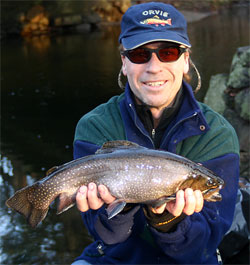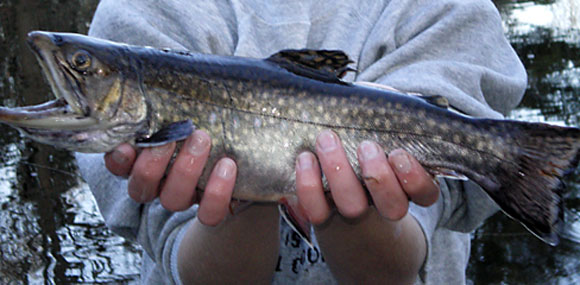Bringing back the salter brook trout
Editor’s Note: At its Dec. 6 meeting, the Nutmeg TU Board of Directors voted to contribute $2,500 of the $5,000 needed to start a fund to help the Sea-Run Brook Trout Coalition bring the fish back to Connecticut.
By Ron Merly
Before brown and rainbow trout were introduced into American waters in the 1860’s and 70’s, the only trout that were naturally found in Connecticut waters were brook trout (actually a char). Brook trout inhabited most of the streams in our state as well as throughout the eastern section of the country. Sea-run, or salter brook trout were brookies that were caught in the salt estuaries of streams emptying into the saltwater throughout New England and on Long Island. The fish were plentiful and were prized by anglers for their size as well as being delicious table fare. It was common to catch salter brook trout between 6 and 10 pounds and not just one.
As the rivers were dammed and polluted from the Industrial Revolution salter brook trout, like their cousin the Atlantic salmon, were unable to reach their traditional spawning grounds and as a result, populations all but disappeared except for a few little known streams scattered throughout New England.
 The Cape has always been a place where these fish were notoriously sought and caught so in the mid 1970’s, restoration work began on remnant populations in Red Brook (See Theodore Lyman Preserve Red Brook Mass) and afterward, several other streams on Cape Cod. The restoration work proved to be a huge success and continues on streams throughout the Cape. Massachusetts government is now behind the restoration and works with T.U. and the Sea-Run Brook Trout Coalition (SRBTC) on these efforts.
The Cape has always been a place where these fish were notoriously sought and caught so in the mid 1970’s, restoration work began on remnant populations in Red Brook (See Theodore Lyman Preserve Red Brook Mass) and afterward, several other streams on Cape Cod. The restoration work proved to be a huge success and continues on streams throughout the Cape. Massachusetts government is now behind the restoration and works with T.U. and the Sea-Run Brook Trout Coalition (SRBTC) on these efforts.
Because of the success of these restorative projects on the Cape, T.U and the SRBTC are interested in the restoration of salters in other New England states. Not every stream is a candidate. The criteria for restoration is pretty simple although the research to discover this simple criteria took years of study. In order for a stream to be a candidate for restoration, it must have a wild population of brook trout in its waters. Stocked brook trout do not survive, only wild fish seem to be able to adapt to the salt. The stream must have no barriers so that the fish can freely travel back and forth from the salt to the river making dam removal neccesary. If the stream to be restored is currently being stocked with any trout, the stocking must stop. Brook trout will not climb steep fish ladders so natural passage is preferred.
Finally, there is a general misconception that trout wind up downstream in the salt because they get washed downstream during heavy flows. Trout do not get washed downstream, they know where to hold during heavy flows. The reason that fish move downstream and into a salt estuary is due to food competition. As a stream becomes more and more populated with fish, there becomes competition for the food source. When the dominant fish chase other fish out of their feeding holds, it causes those fish forced out to seek out a place to eat which is how they eventually wind up in the saltwater. Ironically, those fish that were displaced due to food competition are the ones that will grow large because of the rich salt environment.
T.U. National and the SRBTC have been working with other states to begin restoration in other areas. The first steps toward restoration in Connecticut were recently taken. DEEP biologists, Michael Hopper President of SRBTC, and myself sat down at DEEP headquarters in Old Lyme to establish and begin the restoration of these fish to Connecticut waters. From that meeting, we decided to begin with Anguilla Brook in North Stonington as it meets the general criteria for restoration. The plan is to begin to electronically monitor the brookies starting in the spring.
The state is unable to fund this project currently so we will need to raise funds through grant applications SRBTC and T.U. If you have interest in this project please contact Ron Merly.
